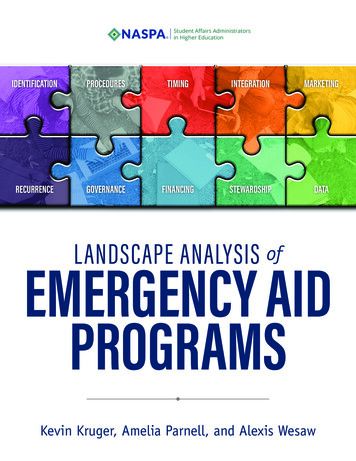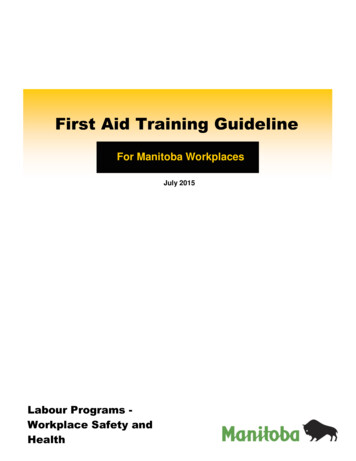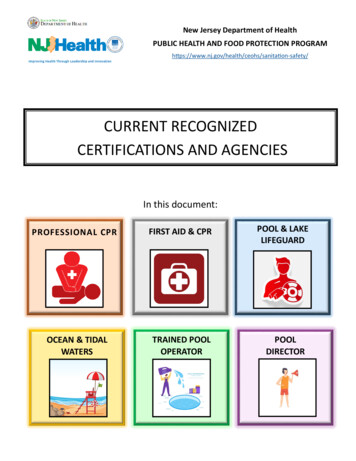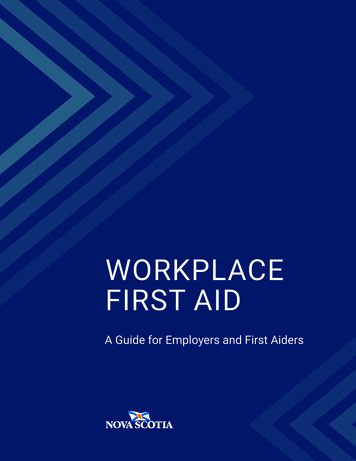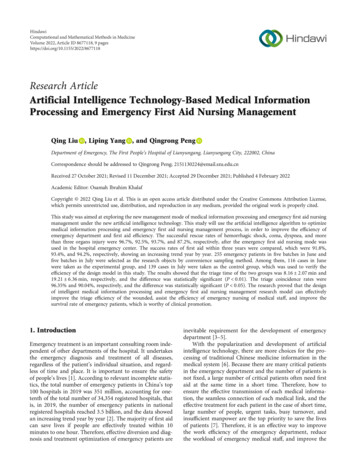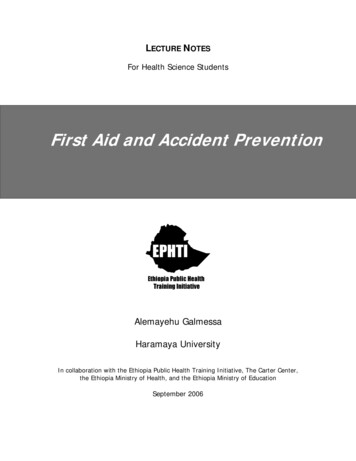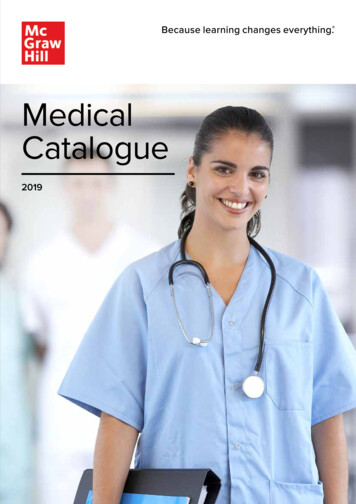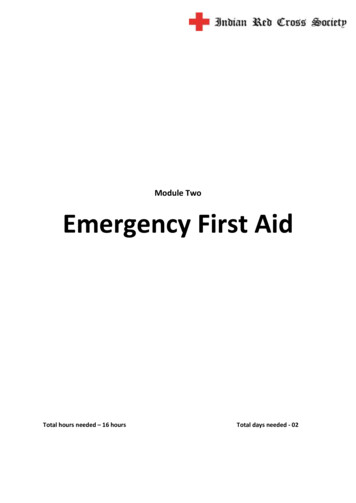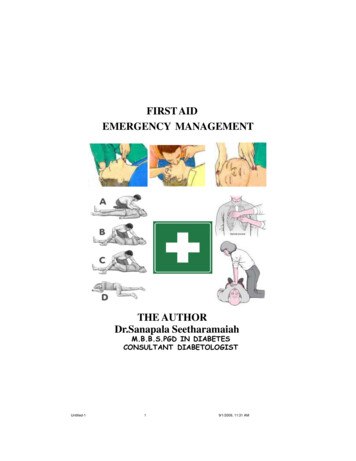
Transcription
FIRST AIDEMERGENCY MANAGEMENTTHE AUTHORDr.Sanapala SeetharamaiahM.B.B.S.PGD IN DIABETESCONSULTANT DIABETOLOGISTUntitled-119/1/2009, 11:31 AM
Contents1.FEW WORDS ABOUT2.FIRST AID3.THE HUMAN BODYRibsUpper limbsLower limbs4.THE RESPIRATIONArtificial RespirationMethods of Artificial RespirationPriorities of ABC of First AidSuffocation mlich maneuverSmoke/gases/fumes5. HE HEARTCirculatory SystemHow to take pulseCardiac resuscitationCardiopulmonary resuscitation (CPR)CPR in Nutshell6. WOUNDS & BLEEDING7. BLEEDINGPressure pointsTourniquetRecovery position (prone position)Other common causes of bleedingUntitled-129/1/2009, 11:31 AM
8. DRESSING & BANDAGESTriangular bandageBasic wound dressingApplications of triangular bandagesRoller bandage for hand and wristRoller bandage for elbowRoller bandage for fingersRoller bandage for heelRoller bandage for ankle and footRoller bandage for leg9. FRACTUREFracture Upper ArmFracture ForearmFracture Wrist and HandFracture Of The Hands And FingersFracture ThighFracture leg and patellaFracture AnkleSprains & StrainFracture Collar bone (Clavicle)Fracture ribsFracture Neck and spineFracture Jaw10. SLINGS AND SPLINTSElevated sling:Collar and cuff slingSplints11. MOVING A VICTIM (TRANSPORT)Fireman lift/carryOther types of carryStretcherUntitled-139/1/2009, 11:31 AM
12. BURNS & SCALDSPercentage of the area of body burnt:Thermal Burns:Electrical Injuries/BurnsWhy are burns Dangerous?Management of Extensive BurnsManagement of Other type of burns13. UNCONSCIOUSNESS14. SHOCK15. HEART ATTACK16. STROKE17. POISONINGSnake BiteInsect bites and stings:Scorpion strings and Spider bitesAnimal bites18. FOREIGN OBJECTSForeign body in the eyeForeign body in the earForeign body in the Nose19. FIRST AID BOXSmall sized first aid boxMedium sized first aid boxLarge sized first aid boxUntitled-149/1/2009, 11:31 AM
MISCELLANEOUS20. EPILEPSY (FITS)21. FEVER (PYREXIA)22. CHICKEN POX23. MEASLES24. ASTHMA25. DIARRHOEA ( MOTIONS)26. DIABETES27. IMMUNIZATION SCHEDULE28. HIV- AIDS29. BLOOD GROUPS & DONATION30. WHOM & WHEN TO GIVE BLOODUntitled-159/1/2009, 11:31 AM
.1Few words about .Being Author is Secretary of St.John AmbulanceAssociation Visakhapatnam branch, Andhra Pradesh responsibility to say few words about my parent organization.St.John Ambulance AssociationSt.John Ambulance Association is a worldwideorganization withNational Head quarters at New DelhiState Head quarters at HyderabadDistrict Head quarters at VisakhapatnamThis organization imparts training in “First aid tothe injured” and issues certificates to those qualifiedwhich are recognized throughout the worldwe are conducting regular training Programs “Firstaid to the injured” to the general public , industrialestablishments and others at our District centre:Address for Communication:SecretarySt.John Ambulance AssociationBhavani Diabetic care centre premises39.11.31, Muralinagar Jn.MadhavadharaIndustrial Estate (PO)Visakhapatnam 530 007Andhra PradeshPhones: 6523999 (R)Untitled-16Cell 98857547669/1/2009, 11:31 AM
2FIRST AIDFirst Aid has been practised ever since the beginningof humanity. Learning First Aid is the civic responsibilityof every citizen. Methods of first aid have been practised ever since one person desired to help another insickness or after an injury. But, an organized worldwideeffort at recognizing the importance of first aid cameonly in the year 1877 with the formation of the St. JohnAmbulance Association of England named after the greatapostle St. John. Over the decades, the importance givento First Aid has grown. Mahatma Gandhi was a greatsupporter of the cause of First Aid, and led a band ofdedicated Ambulance Corps volunteers in 1906 during thetime of the Zulu Rebellion and earlier in 1899 during theFIRST AIDFirst aid is the immediate skilled assistance givento a victim of an accident or sudden illness before medicalaid is available (doctor).AIM OF THE FIRST AID:1. PRESERVE THE LIFE2. PROMOTE THE RECOVERY3. PREVENTS WORSENING CONDITION4.TRANSPORT THE CASUALTYUntitled-179/1/2009, 11:31 AM
1. Preserve the life:a. Maintain airwayb. Breathingc. Circulation2. Promote recovery:a. Encourage confidenceb. Attempt to relieve the pain and discomfortc. Handle the casualty gentlyd. Protect from cold and wet3. Prevent the worsening:a. Unnecessary movements of the injured partb. Dress the woundc. Comfortable support to fracture sited. Place the casualty on well ventilated area4. Transport the casualty to the hospital:a. Call immediate assistance to 108 in AndhraPradeshb. Shift the casualty by other transportGolden rules for the first aid Reach the accident spot immediately Observe the scene which is endanger us to you orcasualty Becalm, confident and quick in action Clear the crowd and ensure fresh air to casualty Assure & reassure the casualty Find and remove the cause Attend the priorities of ABC of first aid If possible, sent information to family membersUntitled-189/1/2009, 11:31 AM
3.THE HUMAN BODYHuman body consists of bones and flesh having206 bones. It has Skull, spines, ribs, upper & lower limbsand pelvis,SkullMiddle ulaTibiaHuman SkeletonUntitled-199/1/2009, 11:31 AM2261425266542852
Ribs: consists of 12 pairs which forms cage and protectsvital organs like heart and lungs.Uses of Bones:1)2)3)4)Untitled-1Firm shape to the bodyProtect the vital organsAttached to muscle and make movementsBone marrow produces blood cells (RBC)109/1/2009, 11:31 AM
Upper limbs: clavicle, scapula, humerus, radius, ulnaand wristShoulder:Upper arm:Forearm:WristPalmUntitled-1clavicle and scapulahumerusradius and ulnacarpel (8)metacarpals (5)Phalanges (three in each finger exceptlittle finger having two) (14)119/1/2009, 11:31 AM
Lower limbs: Pelvis, Thigh bones. Leg bones, Knee,Ankle and FootThigh bonesLeg bonesKnee PatellaTarsals(7)Metatarsals(three smallbones in eachtoe exceptlittle toehaving2 bones)9/1/2009, 11:31 AM
4THE RESPIRATIONBreathing is the process by which air is drawn intothe chest through nose and mouth and is the blown out againthough the same passageRespiratory system consists of:1. Respiratory tracta. Air passages- mouth, nose and tracheab. Lungs2. Muscles connecting with respiratory mechanisma. Ribsb. Diaphragm3. Respiratory Centrepresent in the brainUntitled-1139/1/2009, 11:31 AM
Any where in the Respiratory system injured orblocked leads to suffocation1)Conditions affecting the air passage:a) Obstruction by foreign bodyb) Allergens like gases, food leading to spasmc) Compression of trachea e.g. Hanging, smothering2)Conditions affecting the respiratory mechanisma) Diseases like tetanus and rabiesb) Nerve diseases like paralysis of chest wall anddiaphragm3)Conditions affecting the respiratory centrea) Electric shockb) Large doses of sleeping pillsc) Chr.Alcoholism4)Compressing of chesta) Falling of sand, stones and mud5)Lack of oxygena) High altitudesb) Mines (under ground)Signs & symptoms1. Difficulty in breathinga. Rate of respiration increasesb. Respiration gets shortened2. Bluish discoloration of lips, tips of fingers & toes3. Prominent neck veins4. Gradual loss of consciousness5. Fits may occurs6. Froth from the mount & nostrilUntitled-1149/1/2009, 11:31 AM
How to Asses, if breathing stops:Look and see: chest wall will not moves up anddownListen: you will not hear air flow, when place yourear near nose or mouthFeel: your hand will not move up and down, whenkept on the chest. No feeling of airflow when handkept near nose and mouth.What to do if breathing stops:Management: Untitled-1Remove the causeEnsure an open airway, to allow the air toreach lungsIf the casualty not able to breath normal, toapply artificial respiration159/1/2009, 11:31 AM
ARTIFICIAL RESPIRATIONThis means providing air for a person who is notbreathing or is not making sufficient respiratory efforton their own.It consists of clear Airway and BreathingA : Airway - The passage from the nose and throatto the lungs, which allows air containing oxygen to enterthe body during normal Respiration or Artificial Ventilation. The main causes of an obstructed airway are:* Conscious: Food or other Foreign Body* Unconscious: Tongue or EpiglottisFall of tongueUntitled-1169/1/2009, 11:31 AM
ONB : Breathing - The casualty needs to be breathing for themselves, or assisted in breathing, in order tomaintain oxygen in the body, particularly to the brain.The body and brain in particular can only survive without oxygen for a few short minutes before permanentdamage or death will result.Procedure of Artificial Respiration Lay the casualty on a hard surface in supine position(face to sky) Kneel next to the casualty neck and shoulders Ensure patients airway is clear by checking themouth for any obstruction i.e. any vomits, saliva andremove dentures if any Open airway using the head tilt-chin liftTilt victim’s head back so chin points upward Take a deep breath and place your mouth tightlyover the patient's mouth. Blow air twice steadily for 2 seconds and watch thechest movements (chest raising)Untitled-1179/1/2009, 11:31 AM
If it does not rise, further check for any airwayobstructionRepeat the procedure 15 times per minute till thepatient recovered or medical attendanceFor Babies and Children: Children should receive smaller breaths repeatedat the rate of 20 times per minute. Place your mouth over mouth and nose of casualty Breath gently without over distending the lungsIt is the most effective method of givingartificial respiration, given appropriatelywithout delay,can be life saving.Untitled-1189/1/2009, 11:31 AM
Other Methods of Artificial RespirationIn certain conditions, artificial respiration cannotbe administered like injury to face, jaw bones fracture,consumed poison and drowning. Alternate methods are:Schafer’s method: Place the casualty face downwards, his head rest onhis hand and head turned on side Kneel at legs and place hands on the casualty backjust below the shoulder blades, and rock forwardsand pressing down to compress the chest. Repeatthe procedure for 12 times/minuteSYLVESTER Method : Place the casualty lying on the back, face upwards Extend casualty's hand above head then rock forward and placing hands on the casualty's chest Repeat 12 times a minute.Untitled-1199/1/2009, 11:31 AM
Priorities of ABC of First AidABCAIRWAYBREATHINGCIRCULATIONAny casualty who is in serious condition and requiresimmediate attention on airway, breathing, circulation.Choose priorities of ABC of first aid depends onsituation or CPRA. Airway -The passage from the nose and throat tothe lungs, which allows air containing oxygen to enter thebody during normal Respiration or Artificial Ventilation.See for any obstruction and remove the cause.B : Breathing - The casualty needs to be breathingfor themselves, or assisted in breathing, in order tomaintain oxygen in the body, particularly to the brain.The body and brain in particular can normally only survive without oxygen for a few short minutes before permanent damage or death will result. To look for artificialrespiration.Untitled-1209/1/2009, 11:31 AM
C : Circulation - The Heart is pumping bloodthroughout the body at a sufficient rate to allow forthe exchange of gases (Oxygen and Carbon Dioxide).if fails to do, cardiac compression which is vitalmethod to recover from the cardiac arrestTo look for carotid artery pulse (see above picture), if no pulse starts cardiac resuscitationUntitled-1219/1/2009, 11:31 AM
SUFFOCATIONAsphyxia is a condition in which the lungs do not getsufficient oxygen supply of air for breathing. If thiscontinues for some minutes breathing and heart actionstops and death occurs.kinds of Suffocation:1 Drowning2 Strangulation3 Choking4 Smoke5 Gases and fumesSigns and symptomsInitial phase1. Rate of breathing increases2. Breath gets shorter3. Veins of the neck become swollen4. Face, Lips, nails, fingers and toes turn blue.5. Pulse gets faster and feeble (tachycardia)Later phase6. Consciousness is lost totally or partially.7. Froth may appear at the mouth and nostrils.8. Fits may occur.Note: Even after breathing has stopped the heartmay continue to beat for five to ten minutes. In suchcases it is possible to restore breathing through artificialrespiration, and bring the casualty back to life.Untitled-1229/1/2009, 11:31 AM
DROWNINGDrowning is the result of complete immersion of thenose and mouth in water (or any other liquid). Water enters the windpipe and lungs, clogging the lungs completelythus making the person unable to breath.ManagementThe aim of first aid is to drain out water (or othermatter) from lungs and to give artificial respiration.1. Act quickly. Remove sea weeds and mud from thenose and throat. Start artificial ventilation immediately.This is possible even when the casualty is in water.2. Turn the victim face down with head to one sideand arms stretched beyond his head. Infants or childrencould be help upside down for a short period.3. Raise the middle part of the body with your handsround the belly. This is to cause water to drain out of thelungs.4. Priorities of ABC of First Aid5. Remove wet clothing.6. Kept the body warm, cover with blankets.7. When victim becomes conscious, give hot drinksviz coffee or tea8. Do not allow him to sit up.9. After doing the above, remove quickly to hospitalas a stretcher case.Always perform the Helmlich maneuver on anydrowning victim before you do CPRUntitled-1239/1/2009, 11:31 AM
STRANGULATION/HANGINGStrangulation is pressure on the neck that can causeinjury to the spinal cord, brain stem, or neck structures;complete airway obstruction; cardiac arrest; or death.Strangulation may be1. Purposeful actionOR2. Result from an accident.Observe the scene and do immediately1. Cut or remove the band constricting the throat.2. If suspended, raise the body and loosen or cut therope.3. Priorities of ABC of First Aid4. Inform to police authoritiesUntitled-1249/1/2009, 11:31 AM
CHOKINGChoking is suffocation caused by blockage of thewindpipe (trachea)Common causes:n A weed or a button may get struck on the airpassage commonly seen in childrenn Food may go down in the wrong wayn Water going into the air passage as in Drowningn Irritant gasesn Hanging and Soothering leads pressure onwind pipeIf choking is occurring, the Red Cross recommendsa "five-and-five" approach to delivering first aid First, deliver five back blows between theperson's shoulder blades with the heel of your hand. Next to, perform five abdominal thrusts (also knownas the Heimlich maneuver). Alternate between five back blows and five abdominal thrusts until the blockage is dislodged.Untitled-1259/1/2009, 11:31 AM
Individual with choking:Assisted Chocking:victim is difficulty in breathing:Untitled-1269/1/2009, 11:31 AM
Management:If the victim is in difficulty breathing:Bend her/him over, head lower then the chest,he /she should try to cough out the obstructingobject.:Slap her/him between the shoulderblades 5 times, ifthe above procedure fails, give up to 5 (five) abdominalthrusts (stand behind the person, interlocking your handsbelow the rib case. Pull inwards and upwards)If victim unconscious, turn the victim on to theside,then slap between shoulder blades up to 5 times. Tryto remove obstruction.If the above procedure fails, kneel over victim andgive up 5 abdominal thrusts and see for recoveryIf Unsuccesful, perform artificial respiration/CPRUntitled-1279/1/2009, 11:31 AM
Management in case of an infant1. Hold the child upside down by the legs and smackhis/her back hard three or four times.2. If not successful, lay the child prone with hishead hanging downwards over the knee and give sharpsmacks between shoulders.3. It still not successful, induce vomiting by passingtwo fingers right to the back of the throat.Heimlich maneuverAHA (American Heart Association) RecommendationAbdominal thrusts (also known as the “Heimlich maneuver” (HIM'lik mah-NOO'ver) are a series of under-thediaphragm abdominal thrusts. They’re recommended forhelping a person who's choking on a foreign object(foreign-body airway obstruction).To simplify training of cardiopulmonary resuscitation,abdominal thrusts are recommended for rescuers to use inclearing a blocked airway in conscious adults and childrenover the age of 1. It's not recommended for choking ininfants under age 1.Abdominal thrusts lift the diaphragm and force enoughair from the lungs to create an artificial cough. The coughis intended to move and expel an obstructing foreign bodyin an airway. Each thrust should be given with the intent ofremoving the obstruction.Untitled-1289/1/2009, 11:31 AM
SMOKE/GASES/FUMES1. Protect yourself by a towel or a cloth (preferablywet) over your mouth and nose.2. Always bend low (crawling) while enter into theroom3. Remove the casualty as quickly as possible awayfrom the smoke zone to fresh area.4. Priorities of ABC of First AidSigns & symptoms:1. Rapid, weak pulse2. Headache3. Blurred vision4. Drowsiness (may lead to unconsciousness)5. Breathing difficultiesManagement:1. Before entering the enclosed space take two orthree deep breaths and hold your breath as longas you can.2. Immediately carry or drag victim to fresh air(minimize your exposure to the fumes)3. If the victim is not breathing, start mouth-to-mouthrespirationUntitled-1299/1/2009, 11:31 AM
5THE HEARTCardio vascular system consists of a) Heart b) Arteriesc) Veins d) CapillariesHEART: is a hollow muscular organ having 4 chambersconsits of:a) Rt. Atrium b) Lt. Atrium c) Rt. Ventricle d) Lt.Ventricle and having non-return valvesThe function of the right side of the heart (see rightheart) is to collect deoxygenated blood, in the rightatrium, from the body and pump it, via the right ventricle,into the lungs (pulmonary circulation) so that carbondioxide can be dropped off and oxygen picked up (gasexchange). This happens through the passive process ofdiffusion. The left side (see left heart) collects oxygenated blood from the lungs into the left atriumHuman body having 5 to 6 liters bloodHeart rate 72 beats/minuteBlood is purified by exchange of gases in lungsBlood Consists of:a) R.B.C: contains Hemoglobin, which cariesoxygen to cellsb) WBC: contains protective antibodies whichfights against the bacteriac) Platelets: used for clot when injuredUntitled-1309/1/2009, 11:31 AM
Untitled-1319/1/2009, 11:31 AM
Arteries:They present all over the body and bright red incolor, which carries pure blood (oxygenated) fromthe heart to the tissues of bodyNature of blood flow is spurts, when injuryVeins:They are along with arteries, dark red in colorThey carry impure blood from the body to heartand purified in lungsNature of blood flow is continues, when injuryCapillaries:They are fine and minute blood vessels of arteriesand veins, which exchange the gases and return thegases and nutrients to every tissue of body.Nature of blood flow is oozing, when injuryHow to asses the function of heart failure:If the heart is not functioning, following symptoms andsigns are noticed1. Heart beat is not heard (by placing ear on leftchest)2. Pulse is not felta. Radial artery pulse which is felt below thewrist along thumb sideb. Carotid artery pulse3. No air through nose4. Blue color of lips, tips of fingers and toes5. Dilated pupilIn such circumstance external cardiac compression to begiven to revive the heart functionUntitled-1329/1/2009, 11:31 AM
CIRCULATORY SYSTEMUntitled-1339/1/2009, 11:31 AM
How to take pulseA pulse is the beat you can feel against the wall of anartery, that comes close to the skin. It is the same as theheart rate i.e. 60 to 80 beats/minutefollowing are the most common arteries for countingand feeling your pulse* Radial . This artery is located at the wrist jointjust below the thumb.Pulse at the radial artery* Carotid . This artery is found on the neck on thesides of the wind pipe and neck muscle, lower jaw bone.pulse at the carotid arteryif heart is not functioning do cardiac compressionUntitled-1349/1/2009, 11:31 AM
CARDIAC RESUSCITATION1. Place the casualty on the hard surface in supineposition (face to sky)2. Kneel at one side of the chest3. Give direct blow the chest4. Place the heal of the one hand over the centre ofthe persons chest , between the nipple .place yourother hand on the top of the first hand.5. Press the chest for 60 to 100 times/minute6. Same time observe for breathing, it no breathing doartificial respiration too.after 30 compressions, tilt the head back and lift thechin up to open the airway. Prepare to give tworescue breaths. (ratio 30:2)Untitled-1359/1/2009, 11:31 AM
CARDIOPULMONARY RESUSCITATION (CPR)Cardiopulmonary resuscitation (CPR) is a lifesavingtechnique useful in many emergencies, including heartattack or near drowning, in which someone's breathing orheartbeat has stopped.CPR involves a combination of chest compression andmouth-to-mouth rescue breathing that keeps oxygenatedblood flowing to the brain and other vital organs untilmore definitive medical treatment can restore a normalheart rhythm.CPR is taught to the general public in order to increase the chance of CPR being performed in the crucialfew minutes before emergency personnel are availableRemembers the ABCsAirway, Breathing and CirculationAIRWAY: Clear the airway1. Put the person on his or her back on a firmsurface.2. Kneel next to the person’s neck and shoulders.3. Open the person’s airway using the head tiltchin lift. Put your palm on the person’s forehead and gently push down. Then with theother hand, gently lift the chin forward toopen the airway.4. clear the any contens, broken dentures, vomitus and saliva in the mouth4. Check for normal breathing, taking no morethan 10 seconds: Look for chest motion, listenfor breath sounds, and feel for the person’sbreath on your cheek and ear. If the personisn’t breathing normally or you aren’t sure,begin mouth-to-mouth breathing.Untitled-1369/1/2009, 11:31 AM
BREATHING: Breathe for the personRescue breathing can be mouth-to-mouth breathingor mouth-to-nose breathing if the mouth is seriouslyinjured or can’t be opened.1. With the airway open (using the head tilt-chin lift),pinch the nose and cover the person’s mouth withyours, making a seal.2. Prepare to give two rescue breaths. Give the firstrescue breath — lasting one second — and watch tosee if the chest rises. If it does rise, give the secondbreath. If the chest doesn’t rise, repeat the procedure for 15 times/minute3. Begin chest compressions — go to “CIRCULATION”Untitled-1379/1/2009, 11:31 AM
Open your mouth wide, place it tightly over thevictim’s mouth. Pinch victim’sCIRCULATION: Restore blood circulationLocation of chest compression: Place your handtwo fingers width above the bottom of the sternum ie.l lower end of the chest bone.1. Place the heel of one hand over the center of theperson’s chest, between the nipples (sternum). Placeyour other hand on top of the first hand. Keep yourelbows straight and position your shoulders directlyabove your hands.2. Use your upper body weight (not just your arms) asyou push straight down on (compress) the chest 1 1/2to 2 inches. Push hard and push fast — give twocompressions per second, or about 100 compressionsper minute.3. After 30 compressions, tilt the head back and liftthe chin up to open the airway. Prepare to give tworescue breaths. Pinch the nose shut and breathe intothe mouth for one second. If the chest rises, give asecond rescue breath. If the chest doesn’t rise,repeat the head tilt-chin lift and then give thesecond rescue breath. That’s one cycle. If someoneelse is available, ask that person to give two breathsafter you do 30 compressions.4. Continue CPR until there are signs of movement oruntil emergency medical personnel take over.Untitled-1389/1/2009, 11:31 AM
Untitled-1399/1/2009, 11:31 AM
CPR IN NUTSHELLSteps to save a lifeNew CPR Guidlines of Americaian Heart Assiociation1. Increase the chest compression delivered perminute and reduced interruptions in chest compressions.2. Elimination assessment of signs of circulationbefore beginning of chest compressions3, the first aider to start the chest compressionsimmediately after delivery 2 rescue breaths to theunresponsive victim who is not breathing.simplification of instructions for rescue breaths: allbreaths whether delivered mouth to mouth, to nose,mouth to mask, bag mask or advanced airway should begiven over 1 second with sufficient volume to raise thechest.recommendation of compression to ventilation in theratio of 30:2 whether single or two first aid providerspush hard and push fast at a rate of 100 compressions per minute to allow complete chest recoil and minimize in interruptions in the chest compressions.recommendation that emergency medical servicesselect the procedure depends on situationIf the victim . .Is breathing andhas a pulsestop CPR, and staywith them until help arrivesIs not breathingand has a pulsecontinue rescue breathing.if no breathing.Untitled-1you should40continue rescue breathing.begin chest compressions,alternating with rescuebreathing.9/1/2009, 11:31 AM
NEED ASSESMENTcall assistant/108 ambulance servicesue breathing.mpressions,th rescueCHECK FOR BREATHINGUntitled-1419/1/2009, 11:31 AM
TWO RESCUE BREATHSCHECK THE CAROTID PULSEneed assesment for circulationUntitled-1429/1/2009, 11:31 AM
POSITION HANDS IN THE CENTRE OF CHESTFIRMLY PUSH DOWN TWO INCHES ON THECHEST 30 TIMESCONTINUE WITH TWO BREATHS AND 30COMPRESSIONS UNTIL HELP ARRIVES.Untitled-1439/1/2009, 11:31 AM
6WOUNDS & BLEEDINGWounds: break in the continuity of tissues of the bodyBleeding: injury to the blood vessels due to woundsTypes of the wounds:1) Abrasions: scratch injury to the superficial layersof the skin2) Contusions: caused by blunt instruments or bycrushing. Tissues are bruised3) Incised: caused by sharp instruments like knives,razor. The tissue having clear edges and bleedsprofusely.4) Lacerations: caused by machinery, claws of animals,fall on rough objects and tissues having irregularand rough edges, bleeds less5) Punctured: caused by sharp, pointed objects likenail and needle and knife that pierces or penetratesor pierce the skin. Wound is deep in nature, infection spreads easily6) Gun shot wounds: caused by firing having smallopening and large exit wound. It is very serouswound immediate medical and surgical treatment.Squeal of wounds:v Infectionv BleedingCauses of infection:1. Object caused by the wound anddepth of the wounds2. Skin & clothes of casualty3. Dirty dressing4. Contaminated water cleaningUntitled-1449/1/2009, 11:31 AM
Untitled-1459/1/2009, 11:31 AM
Wound Management:There are six main steps for treating a wound.123456Put on rubber gloves ( if available)Stop the bleedingClean the woundApply an antibiotic ointmentDress the woundCheck for infections1. Put on Rubber Gloves (optional)If you are treating a person with a communicable orinfectious disease, pull on a pair of rubber gloves.2. Stop the BleedingBefore you clean or dress the wound, you need tostop the bleeding by direct pressure (light pressure).Most wounds stop bleeding with light pressure. Cover thewound with sterile gauze or a clean cloth and then applygentle pressure with the palm of your hand. The clothabsorbs the blood and will promote clotting. If bloodsoaks through, don’t disturb the cloth. Apply a secondcloth on top of the first.if the bleeding is not controlled,l by applying Indirect pressure point on major artery supplying tothewound /or apply tournquet (details in bleeding chapter)If the wound is on an arm or leg that doesn’t appearto be broken, applying light pressure and elevating thebody part to a height above the person’s heart will allowgravity to slow the blood flow.Untitled-1469/1/2009, 11:31 AM
3. Clean the WoundRun water over a wound, and use a cotton ball withwater to remove dirt from the wound. If dirt or debrisremains in the wound after washing, use tweezers cleanedwith alcohol to remove the particles. If debris remainsembedded in the wound after cleaning, see your doctor.Thorough wound cleaning reduces the risk of tetanus. Toclean the area around the wound, use sterile cloth/gauge.There's no need to use hydrogen peroxide, iodine or aniodine-containing cleanser. These substances irritateliving cells and delay the healing.4. Apply an Antibiotic ointmentAfter you clean the wound, apply a thin layer of anantibiotic ointment to help prevent infection. Theseointments may help the wound heal better (without scarring), and act as a barrier against infection. ointmentslike soframycin and betadin are preferable5. Dress the WoundAfter covering the wound with an antibiotic ointment, gently cover the wound with sterile gauze pad andbandage the wound6. Check for InfectionSwelling, tenderness, localized pain and fever aresymptoms for infections of the wound See your doctorimmediately if you notice any sign of infection.Untitled-1479/1/2009, 11:31 AM
7BLEEDINGBleeding: injury to the blood vessels due to wounds orany other causeThere are two types of bleeding:1.external bleeding which is obvious and apparent2. Internal bleeding where the bleeding is notapparent at the outset but may manifest itself later inthe form of bleeding from the nose, ear, lungs or stomach.Signs and Symptoms of Bleeding:* Giddiness* The skin becomes cold and clammy.* The pulse becomes rapid and weak.* Profuse sweating may occur.* Breathing becomes shallow and the patientmay gasp for air and sigh deeply.* Thirst may be prominent.* The patient may feel faint and even collapse* DeathIdentify the source of bleeding:Bleeding may occur from the arteries, veins or capillaries or from combinations of the three. It can be identified by the following characteristics:Arte
supporter of the cause of First Aid, and led a band of dedicated Ambulance Corps volunteers in 1906 during the time of the Zulu Rebellion and earlier in 1899 during the 2 FIRST AID FIRST AID First aid is the immediate skilled assistance given to a victim of an accident or sudden illness before medical aid is available (doctor). AIM OF THE FIRST .
